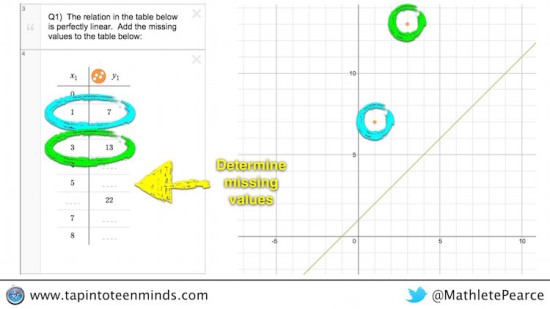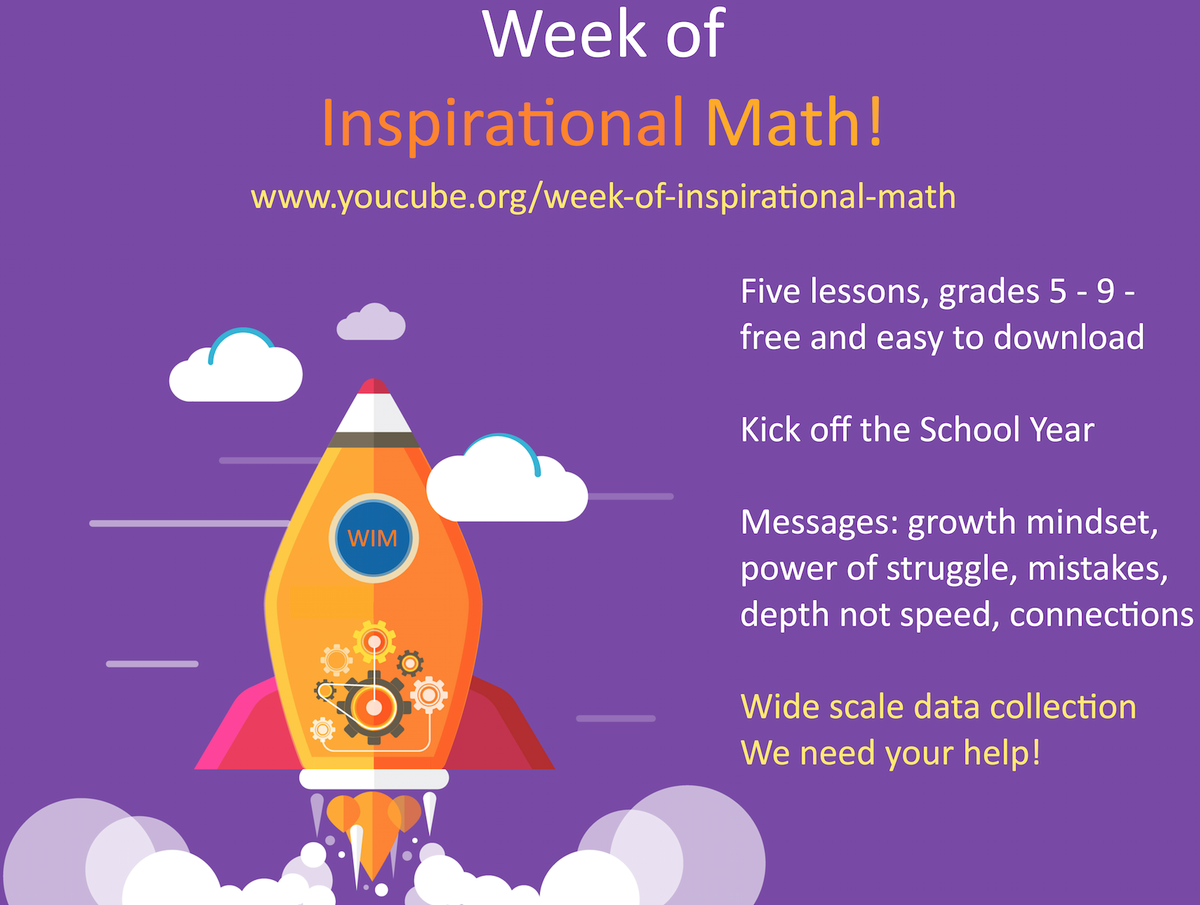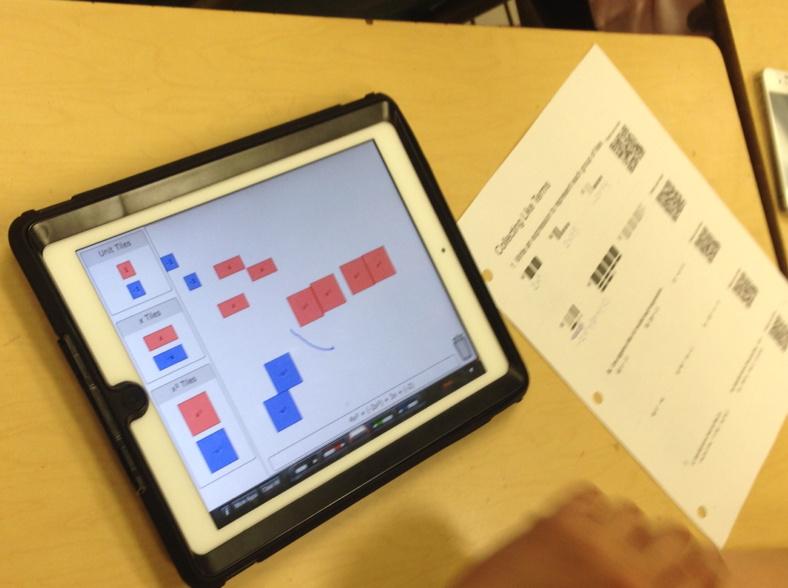
I am always looking for interesting ways to co-opt technology to do things it wasn't intended to do.
@joe_sisco has done just that with Google Drawings. Some of you may have word walls in your math classrooms and Joe has, for many years, developed more enhanced word walls that usually incorporate images related to that particular topic. Now he has converted those word walls to Google Drawings and is using an interesting feature that allows you to place things outside of the drawing but still visible.
So if you look at the image below, the centre part represents the actual word wall and if you were to print it out, that is what you would see. But the interactive part comes from students who drag the numbered circles from the right onto the wall to indicate where those items are (the numbers correspond to the words). A finished student example is seen on the right. So if students open this in Google Drawings they see the interactive image below and then if they print it out they would see the image to the right.
The entire collection (there are over 20 so far) is shared at the link below, you can open any one and print out the word wall portion (or save it as a PDF) or you can copy any one to your own Google Drive and start the interaction. Also if you are into it, there is a template to create your own. And you might want to start with the "How to Use this Folder" file for a more detailed view of the instructions.
Curriculum Tags: All
http://bit.ly/INTERACTIVE_WORD_WALLS

We have two new activities on our Engaging Math blog. The first is a simple matching activity with cards. Students are put in groups and given a set of cards (there are four different sets) and then they have to match the word sentence with the expression. This is not meant to be an activity that takes very long but simply eases students into a comfort level with algebra.
Curriculum Tags: Gr7, Gr8, MPM1D, MFM1P
http://engaging-math.blogspot.ca/2015/04/connecting-words-and-algebraic.html
The second activity is a Geometer's Sketchpad file that is for students to investigate properties of parallel lines. It is optimized for the iPad. Take a look at the video below to see how it works then follow the link to download the file
Curriculum Tags: Gr8, MPM1D, MFM1P
http://engaging-math.blogspot.ca/2015/04/geometers-sketchpad-investigate.html

I like this activity by Kyle at Tap Into Teen Minds. It adds to the rash of great activities that use a series of Desmos graphs to walk through a concept. In this case it's the idea of the connection between graphs and tables of values with linear functions. It starts with
this graph with equations and then moves through several others. One thing I really like is the idea of trying to fill in values in a table and then seeing right away that the points are linear. Take a look a the full description at the link below.
Curriculum Tags: MPM1D, MFM1P, MFM2P
https://tapintoteenminds.com/2015/03/26/desmos-math-journey-linear-relations/

I like this as an introduction to logarithms. That is, it is a way to solve exponential equations (at least simple ones) by first getting students comfortable with the idea of what the solution means. And doing this with a puzzle type atmosphere.
Curriculum Tags: MHF4U, MAP4C, MCT4C
http://squarerootof......oneteachmath.blogspot.ca/2015/03/
In grade 12 data management it seems reasonable to talk about random controlled trials and why they are so important for research (especially medical research). With that being said, this recent Freakonomics Radio podcast is about that very thing. Certainly worth a listen, if only to gain insight we can pass on to our students. Personally, it's the kind of thing I would have students listen to and then have the discussion afterwards.
Curriculum Tags: MDM4U
http://freakonomics.com/2015/04/02/how-do-we-know-what-really-works-in-healthcare-a-new-freakonomics-radio-podcast/
And one more from Tap Into Teen Minds. These two are on how to use Explain Everything to have students investigate angle relationships. I like the idea of using the protractor and visually comparing the size of the angles by just colouring them in. See how it works with the video below.
Curriculum Tags: Gr8, MPM1D, MFM1P
https://tapintoteenminds.com/2015/04/07/explain-everything-math-learning-journey/
https://tapintoteenminds.com/2015/04/08/explain-everything-angle-triangle-journey-part-2/
I stumbled upon this "fan" site for the Roll up the Rim to Win contest. There is a lot of controversy about the distribution of prizes amongst provinces as well as whether it is more advantageous to purchase larger sized cups (because they win more often). So this site allows you to enter your own data and so far they have collected over 14,000 data entries. Then they give you all sorts of graphical analysis of the data. At the very least you could use it to have a discussion on why this data might be biased.
Curriculum Tags: Gr7, Gr8, MBF3C, MDM4U
http://rollupthestats.com/
 Some lessons to engage students with math and mindset are going to be available in May from Joe Boaler's YouCubed site. Follow the link below to register and get the grade 5-9 lessons for free starting in May.
Some lessons to engage students with math and mindset are going to be available in May from Joe Boaler's YouCubed site. Follow the link below to register and get the grade 5-9 lessons for free starting in May. It's funny that I was just introduced to this algebra tiles app by someone and Jon Orr has a post about it. In fact, there is a whole suite of manipulative apps from the same developer, They are not free but they are very good. Although, I would rather have kids work with the physical things, sometimes using the app is better for some. Here Jon, not only shows how to use the app but I like the idea of worksheets with answers available via QR codes.
It's funny that I was just introduced to this algebra tiles app by someone and Jon Orr has a post about it. In fact, there is a whole suite of manipulative apps from the same developer, They are not free but they are very good. Although, I would rather have kids work with the physical things, sometimes using the app is better for some. Here Jon, not only shows how to use the app but I like the idea of worksheets with answers available via QR codes. This is a nice idea and a nice little sorting activity. When we have multiple sets of the same activity (for groups) we copy each set on a different colour (like this set of Tarsia cards) so that it's easy to re-sort them if they get mixed up. Here is a post about doing the same thing but it uses a sorting activity for exponential functions as a download.
This is a nice idea and a nice little sorting activity. When we have multiple sets of the same activity (for groups) we copy each set on a different colour (like this set of Tarsia cards) so that it's easy to re-sort them if they get mixed up. Here is a post about doing the same thing but it uses a sorting activity for exponential functions as a download.


















